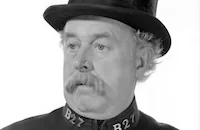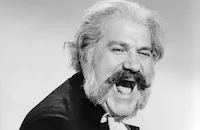The Great Diamond Robbery

Brief Synopsis
Cast & Crew
Robert Z. Leonard
Red Skelton
Cara Williams
James Whitmore
Kurt Kasznar
Dorothy Stickney
Film Details
Technical Specs

Synopsis
At the New York office of wealthy jeweler Bainbridge Gibbons, diamond cutter Ambrose C. Park learns that his employer has invested his entire fortune in the Blue Goddess, a gem so valuable that Lloyds of London will not insure them to cut it. Ambrose insists that Sahutsky, the senior cutter, has erred in his calculations and will damage the precious stone, and pleads for the opportunity to cut the diamond himself. Gibbons refuses, and Sahutsky, who has been sedated by a doctor in preparation for the task, begins work. However, he cannot take the pressure and, cursing his profession, walks out. Later, as Ambrose is eating his lunch in Central Park, he shows a stranger an ad he has placed in the newspaper seeking information about his parents, who abandoned him on a park bench years before. Ambrose explains that he runs the notice each year on his birthday, adding that he was given the name Ambrose Central Park at the orphanage where he grew up. That evening, while celebrating his birthday alone in a café, the tee-totaling Ambrose inadvertently gets drunk on a bottle of plum liqueur and is arrested for disorderly conduct. At the police station, Ambrose encounters slick lawyer Remlick, who assures Ambrose he can locate his family for $400. Remlick is about to disappear with the money when Ambrose remarks that he would gladly give half of his life savings to be reunited with his family. Impressed by Ambrose's modest but respectable bank account, Remlick hatches a scheme to relieve him of all his money, and enlists his shady friend Duke Fargoh to impersonate Ambrose's father. Duke persuades his former girl friend, Emily Drumman, to pose as Ambrose's mother by promising to marry her. Remlick arranges for Ambrose to meet his "family," which includes Emily's pretty daughter Maggie. To Remlick's surprise, the reunion is interrupted by the arrival of Duke's friends, mobsters Tony and Herb, who pretend to be Ambrose's uncles. When Ambrose steps out, Tony identifies himself to Remlick as notorious criminal Tony Midelli, but declines to explain his interest in the small-time scam. Over supper, Tony steers the conversation toward Gibbons and the two million dollar Blue Goddess. Ambrose then accompanies Maggie to the nightclub where she works as a dancer, and when a drunken patron gets fresh with his "sister," Ambrose fights with him and gets Maggie fired. When Ambrose returns to work, Gibbons introduces him to the famous Dutch diamond cutter Van Goosen, and Ambrose offends him by disputing his calculations on the Blue Goddess. Ambrose, who has moved in with Duke and Emily and changed his last name to Fargoh, expresses his concerns about the Blue Goddess at home. Tony urges Ambrose to bring the diamond home and cut it himself, arguing that this would be in Gibbons' best interest, and Ambrose agrees. The following evening, Emily and Maggie protest the scheme, and the thugs tie them up and hide them in the bedroom before Ambrose comes home. He arrives without the diamond, however, having decided that removing it from the office would be stealing. Tony proposes that they accompany him to the office, where Ambrose can cut the diamond before Van Goosen is scheduled to arrive. The naïve Ambrose brings his "family" to the office and, after getting them past security, prepares his equipment. Meanwhile, Emily and Maggie free themselves and attempt to call Ambrose to warn him that Tony and Herb plan to steal the diamond, but the call is intercepted by Tony. The women go to the office and burst in before Ambrose can cut the diamond, confessing their deception. In the ensuing scuffle, Ambrose sets off the alarms, then hastily cuts the diamond, separating it into two perfect halves, which he and Maggie swallow. The police arrive to arrest the criminals, and Ambrose and Maggie are taken to the hospital to have their stomachs pumped. Gibbons meets them at the hospital and praises Ambrose for his work. Ambrose is morose over the loss of his new family, but perks up once he realizes that Maggie is not really his sister. As the proud Emily looks on, Ambrose asks Maggie to marry him.

Director

Robert Z. Leonard
Cast

Red Skelton

Cara Williams

James Whitmore

Kurt Kasznar
Dorothy Stickney
George Mathews

Reginald Owen
Harry Bellavar

Connie Gilchrist

Steven Geray

Sig Arno
Mario Siletti
Tom Moore
Pat O'malley
Larry Blake
Michael Dugan
Thomas P. Dillon
Earl Lee
Chris Warfield

Jack Kruschen
Jimmy Ames
Robert Forrest
Edward Cassidy
Robert E. Griffin
Anna Q. Nilsson
William Tannen
Harry Strang
Olan Soule
Mary Parker
Michael Ross
Linda Danson
Judy Landon
Stuart Randall
Matt Moore
G. Pat Collins
William Haade
Jean Fenwick
Crew
Daniel B. Cathcart
Grace Dubray
Cedric Gibbons
Sydney Guilaroff
Charles Hunt
Edwin H. Knopf
Rudolph G. Kopp
Jack D. Moore
Joseph Nayfack
Fenton Norwood
Maurice Pinto
Martin Rackin
Joseph Ruttenberg
Douglas Shearer
William Tuttle
Laslo Vadnay
Laslo Vadnay
George White
Edwin B. Willis
Dolph Zimmer

Film Details
Technical Specs

Articles
The Great Diamond Robbery
By Richard Harland Smith

The Great Diamond Robbery
Quotes
Trivia
Notes
Although the character played by Kurt Kasznar is listed in the onscreen credits and reviews as "Louie," he is identified in the film as "Tony Midelli." Reginald Owen is billed above George Mathews in the opening credits, but below him in the end credits. A studio publicity release, dated December 8, 1952, stated that production had begun that week, and that George Oppenheimer was collaborating on the screenplay with credited writers Laslo Vadnay and Martin Rackin. Production was delayed until March 1953, however, and Oppenheimer's contribution to the film has not been determined. The publicity release also included Adolphe Menjou and Horace McMahon in the cast, but they were not in the film. A December 1952 Hollywood Reporter news item adds Harry Cheshire to the cast, but his appearance in the final film has not been confirmed. According to an April 1953 Hollywood Reporter news item, Bronislau Kaper was originally to do the musical score.

Miscellaneous Notes
Released in United States Winter December 1953
Released in United States Winter December 1953














